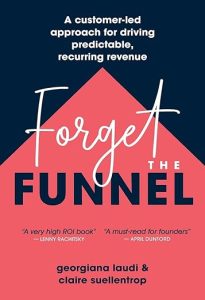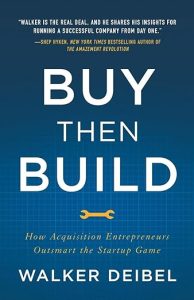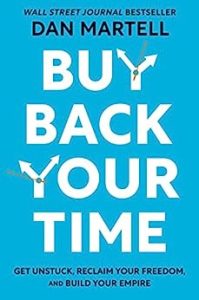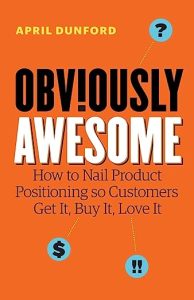Forget The Funnel is a cleverly named book that focuses on Customer Led Growth strategies. The premise of the book comes from the authors obsessing over typical marketing metrics like traffic and leads, to centering their view of growth on customer value.
The biggest problem this book seeks to address it the typical strategies and tactics marketing teams use to find and acquire customers that feels cyclical and underperforming. Customer Led Growth is a different approach that enables a shared balance between metrics and customer value which turns into revenue for the company.
Below I highlight some of my takeaways from Forget The Funnel. Also, please note there is a website that goes with the book and is a helpful resource.
Building Your Customer-Led Team
This chapter has some useful tips on how to get key stakeholders on board with customer led growth. The authors go so far as to provide email templates and frameworks for getting the project stood up and aligned.
Learning From Customers
The main focus of this chapter is shifting your strategy from presumed customer pain points to real customer pain points. The basis for this is understanding that neither demographic data nor product data tells you what is inside your customers head.
So what should you do instead?
Instead, you want to create a documentary of your best customer’s journey: from the struggle, to the search for solutions, to finding your product, to trying it, to buying it and being so happy that someone would now have to pry it from their hands.
What are good questions to ask customers?
- How are you using [product name] day-to-day?
- When did you first start using [product name]?
- Okay, so with that timeline in mind, take me back to life before [product name]. Prior to [product name], what were you using instead?
- If you were using a combination of any tools or products, what were those? Tell me about the moment you realized [old way] wasn’t cutting it.
- What caused that moment?
- What compelled you to look for something different?
- Where did you go to look for new solutions?
- Did you try anything else before [product name]?
- How did you find out about [product name]?
- Why did you decide to choose [product name] over other options?
- Can you recall anything that stood out to you?
- When you signed up for [product name], what happened that made you feel certain it was the right solution for you?
- Now that you have [product name], what’s the number one thing you’re able to do that you weren’t able to do before?
- What do you wish [product name] did that it doesn’t do today?
Should you survey or interview to ask these questions?
| Number of ideal customers | Method | Target Number Of Participants |
| 500 or fewer | Interviews | 10-15 interviews |
| More than 500 | Survey | 25-50 survey response |
Learning From Future Customers
Customer research is your best tool to drive customer-led growth—when you have customers to get insight from. When you’re launching a new product, or suddenly need to pivot, like Paytouch, or when you don’t yet have enough pry-it-from-my-hands customers, audience research is your ticket.
Audience research is learning from your target audience or potential customers out in the world experiencing the problem that you help solve. Audience research helps you understand: what influences the people you’re trying to reach; who they listen to and trust; where they go when they’re looking for new solutions; and other solutions they’re trying, and why those solutions are/aren’t working for them.
Website Survey Questions
The goal of your website survey is to document your potential customer’s life before they’ve found a solution. Here are the questions to ask:
- Which of these best describes you?
- I’m considering a [product type] for the first time; not sure it’s for me yet.
- I know I need a [product type]. I’m just trying to find the best option.
- I know [product name], but I’m not a customer yet.
- I’m already using [product name]. I’m just here to sign in.
- Other [click to type].
- What tool(s) do you currently use for [problem], if anything? (online or offline)
- Is there anything you dislike or want to change about your current solution(s)? If so, please describe.
- What matters most as you look for a new solution?
- Is there anything holding you back from [booking a demo/signing up] right now?
Identifying Your Customer’s Jobs-To-Be-Done
When we say “Jobs-to-be-Done,” what we mean is: The struggle… That motivated customers… To seek a desired outcome.
To understand the Job your customer “hires” your solution for—the one that led them to “fire” their past solution, search for new ones, and ultimately choose yours—you need clarity on:
- The struggle… (When I…)
- That motivated customers…(help me…)
- To seek a desired outcome (so I can…).
Taken together, these three elements (struggle, motivation, desired outcome) summarize your customer’s experience into a customer job statement (Figure 5.1).

Example
When I need a way to automate my marketing content…(struggle) Help me manage it all in a way that’s simple but still helps me be strategic…(motivation) So I can feel more confident and organized (desired outcome).
Now that we have a framework to do something with the survey/interview data from above we can break down the responses into themes so we know where to put them in the JTBD framework.
Example from customer survey response
| Customer | Survey Response | Struggle Theme |
|---|---|---|
| Customer A | “I was struggling to post on social media every day, on top of doing all of the other business things! Engagement was really low, and my community wasn’t hearing enough from me. | Increase marketing presence |
| Customer B | “I wanted to resuse the content I was working so hard on.” | Reuse content |
| Customer C | “I needed more automation, I am a very busy person.” | Save time and automate |
I can give more examples but you get the idea. Map your customer’s response to a….
- Struggle theme
- Motivation theme
- Desired outcome theme
Rethinking Customer Journey Maps
Generic frameworks like buyer journey maps and pirate metrics center on the business getting value rather than the customer getting value. They fall short in two specific ways:
- They shoehorn all customers’ experiences into a generic set of stages—regardless of your product, industry, pricing model, customer, or problem being solved. Your typical buyer journey map breaks down into three buckets: awareness, consideration, and purchase. End of story. This flattens all of the smaller steps your ideal customer actually goes through in their real-life experience. With this critical context lost, your team can only guess where your opportunities for growth are—not to mention the lost opportunities for recurring revenue businesses whose success only begins at first purchase.
- They incentivize your team to focus on transactional moments over customer value moments. It’s common for teams to measure their success based on metrics like “signup” or “paid.” But this puts value to the business at the center of the story; not the customer’s. Operating like this can lead to shortsighted thinking over time. This is especially risky for recurring revenue businesses who must continually prove their value to customers.
The Anatomy Of Your Customer Experience
Mapping the customer’s experience starts by breaking it down into three main phases:
- The Struggle phase: your customer realizes they have a problem and begins seeking and exploring possible solutions
- The Evaluation phase: your customer commits to try your product and decides it’s the solution they were looking for
- The Growth phase: your customer successfully embeds your product into their daily life and even may use it in new ways beyond the scope of the original problem.
Within each phase, there are three questions you’ll answer using your customer data:
- What is the customer thinking as they struggle, evaluate, and grow?
- What is the customer doing as they struggle, evaluate, and grow?
- What is the customer feeling as they struggle, evaluate, and grow?
| Struggle | Evaluation | Growth | |
|---|---|---|---|
| Thinking | |||
| Doing | |||
| Feeling |
Take your survey/interview data and start mapping it into each of these phases.
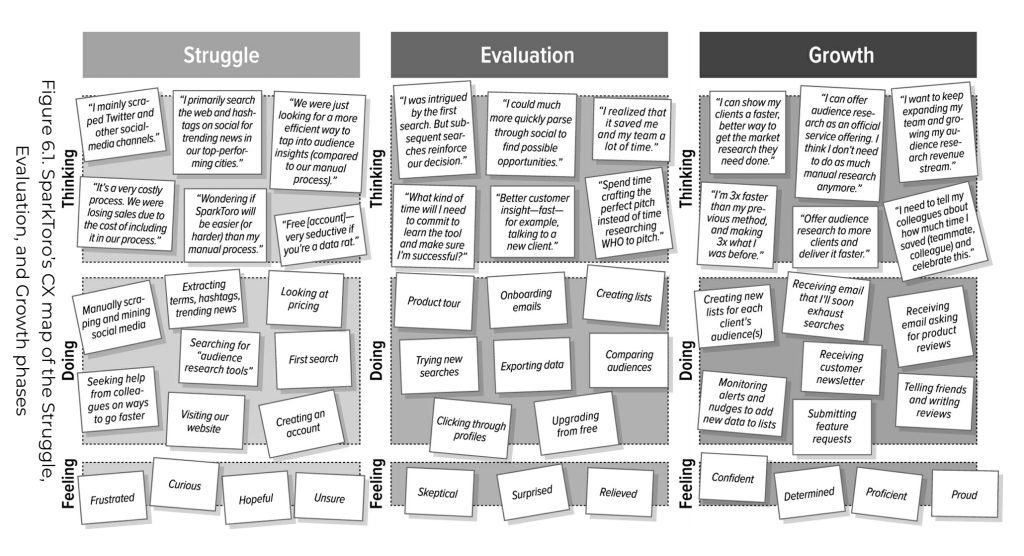
The final step in completing this new approach to a customer journey map is translating the feedback into the value based on milestones. Everything rests on your ability to deliver continued value to customers.
The final result looks like this…
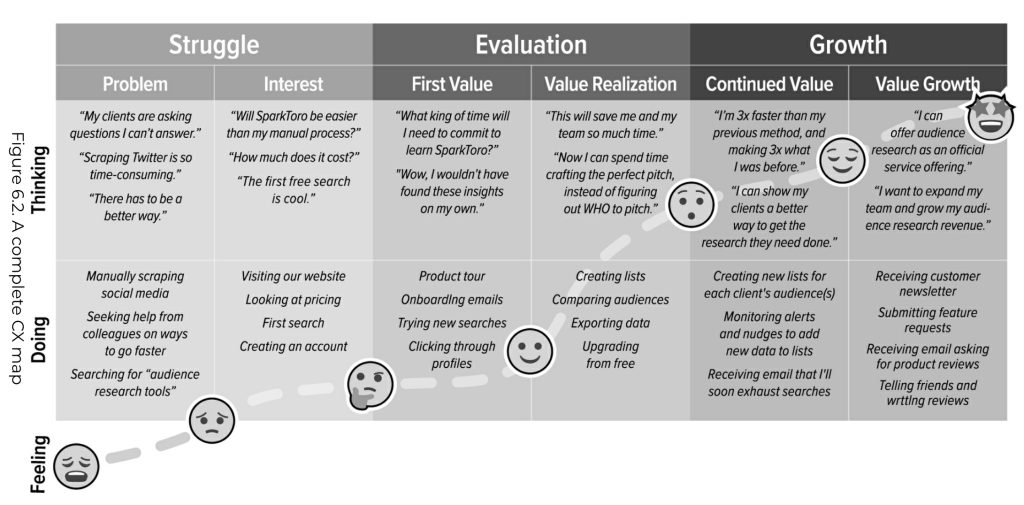
Identify Customer-Led KPIs
Most marketers will agree with everything up until this point. The biggest gap (which the authors now address) is how do you measure success.
The authors suggest leading and lagging indicators for each milestone in the customer journey map.
Here is an example from the above company (SparkToro)
For SparkToro (as with most companies), that action is the customer visiting their website for the first time. It’s trackable. It also tells the team their efforts are paying off.
Example
| Struggle | Evaluation | Growth | |
|---|---|---|---|
| Problem | Interest | First Value | Value Realization |
| New unique website visitor | First search | 10+ searches and 2+ lists and 1+ export |
Wrapping it up
Those were the biggest insights I took from the book. I would recommend this book to anyone struggling to understand the value they are giving their customers or how they can give more of it to hit their revenue goals. This quote stood out to me towards the end of the book.
Where there is customer value to add, there is revenue to gain.
Georgiana Laudi & Claire Suellentrop
Where there is customer value to add, there is revenue to gain.
Laudi, Georgiana; Suellentrop, Claire. Forget the Funnel: A Customer-Led Approach for Driving Predictable, Recurring Revenue (p. 129). Lioncrest Publishing. Kindle Edition.
Join The Newsletter
Get occasional emails from me when I publish new projects and articles.
